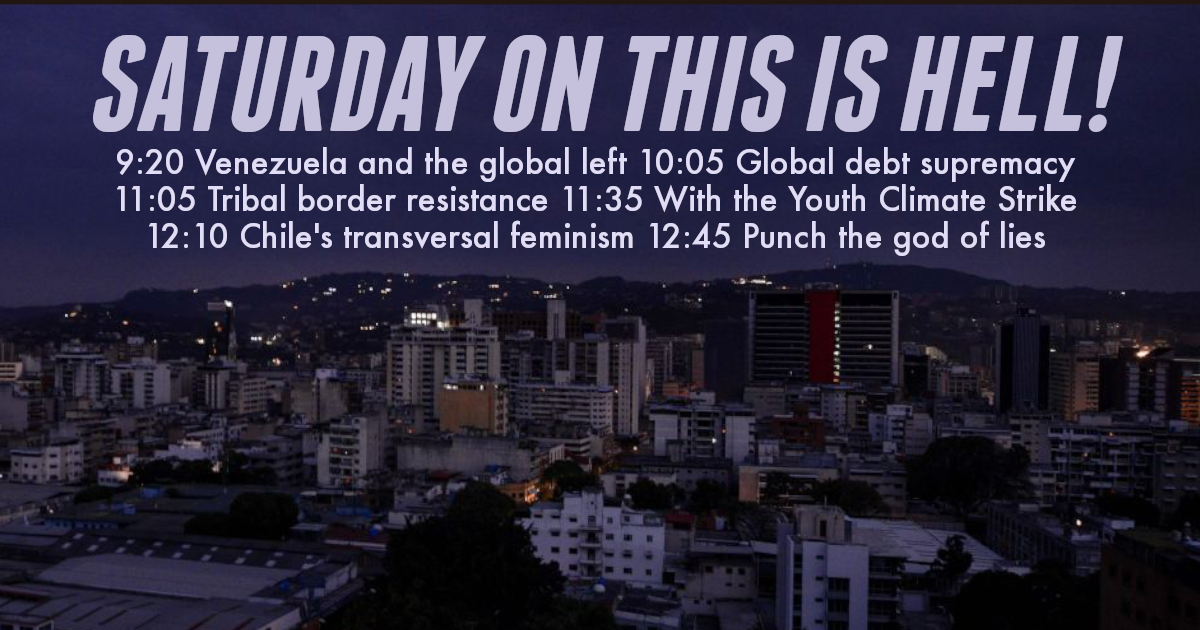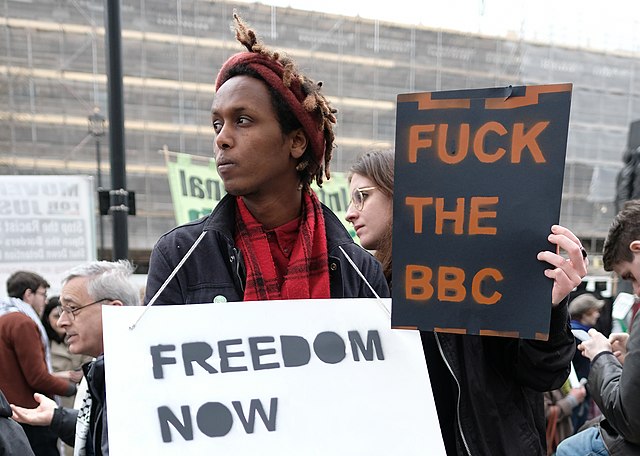
Terence Keel returns to discuss his new book from Beacon Press, The Coroner's Silence: Death Records and the Hidden Victims of Police Violence. "The Moment of Truth" with Jeff Dorchen follows the interview.
Help keep This Is Hell! completely listener supported and access bonus episodes by subscribing to our Patreon.
Please rate and review This Is Hell! wherever you get your podcasts. It really helps the show ascend the algorithm to reach new listeners.
Welcome to the Moment of Truth: the thirst that is the drink.
I’m going to say this twice. Once here at the top, and a second time near the end. The first time because I think it’s something on which everyone who opposes the controlling economic, political, and information system, as it is, can all agree. The second time because I will want to remind us all of its salience in light of what I’m about to lay out: the basis of a unified conspiracy theory of global fascist movements, large and small, in governments and in the streets.
This is the statement I wish to color all that will proceed hence: The establishment opposed to Donald Dump believe there is a line, below which he sits, on his tasteless gold toilet, tweeting his misspelled words and doing his second-tier, declasse-collar crimes, while they look down their noses from their understated, right-thinking, right-acting positions of propriety. What they don’t realize is that, while they bend over to scold him and dirt-devil up the shards and crumbs of the taco bowl he left on their lovely carpet, Dump is actually their own ass crack hanging shamefully out of the back of their silk-linen blend trousers.
I’m not arguing that Donald Dump conspired with Russia to break laws and undermine the 2016 election. He and/or his shitty family may have done that, and there may be evidence in the Mueller report that warrants further investigation into that. There is certainly the appearance of impropriety, which is one reason there was an investigation in the first place.
Hillary Clinton didn’t lose the 2016 election because of Bernie Sanders or because of Russia. The British public didn’t vote “leave” because of Russian interference. I want to make it clear that I am in no way pushing those narratives. But that doesn’t mean Russia’s noodling around, egging rightward mischief here and there, while entangled in shady deals for a few million here, a few million there, isn’t a dark-money connection worth understanding. It is. John Gotti was a little tiny parodic maquette of the larger capitalist system, but he had to be brought down. Jon Burge wasn’t in charge of all the racism in Chicago, but he was a problem, and if he could die again much more brutally, that would be a good thing.
The premise that, as a wise man named Chuck Mertz has said time and time again, “Everybody’s... read more

Listen live from 9AM - 1:00PM Central on WNUR 89.3FM / stream at www.thisishell.com / subscribe to the podcast
9:20 - Political economist Andrew Fischer studies poverty, and the study of poverty, beyond the neoliberal frame.
Andrew is author of Poverty as Ideology: Rescuing Social Justice from Global Development Agendas from Zed Books.
10:05 - Writers Duncan Tarr and Noor us-Sabah explore the Midwestern oil pipeline that ties us all together.
Duncan and Noor wrote the article The End of the Line for Commune.
10:35 - Journalist Claire Provost traces money fueling Europe's far right back to US Christian fundamentalists.
Claire Provost is co-author of the report Revealed: Trump-linked US Christian ‘fundamentalists’ pour millions of ‘dark money’ into Europe, boosting the far right from openDemocracy.
11:05 - Philosopher Cinzia Arruzza examines the anticapitalist, eco-socialist and antiracist reach of a feminist for all.
Cinzia is co-author of Feminism for the 99%: A Manifesto from Verso.
12:05 - Live from Ankara, journalist Max Zirngast reports on Erdoğan’s autocratic grip tightening over Turkey.
Max is co-author of the article Discontent Is Brewing In Erdoğan’s Turkey from Jacobin.
12:45 - In a Moment of Truth, Jeff Dorchen pulls a thread and unravels a unified conspiracy theory of fascism.
Welcome to the Moment of Truth: the thirst that is the drink.
I like Purim. Purim is the Jewish Carnivale or Mardi Gras. It celebrates the story of Esther, who saved the Jews from destruction during the Babylonian captivity. The Biblical story was embellished in some aggadot, or Talmudic stories, and later apocryphal legends and early medieval fan fiction. The Targum Esther, or Targum Sheni, from about the 4th century CE, and the Targum Yerushalmi, really go to town in their elaborations on the tale. They expand the Megillah the way Spike Jonze took “Where the Wild Things Are,” a 38-page book that’s mostly pictures, and turned it into a two-hour horror movie that was basically The Revenant meets HR Puffinstuff. I drew most of my information from Volume IV of Louis Ginzburg’s 7-volume masterpiece of lore-gathering, The Legends of the Jews.
Part of the celebration of Purim is the telling of the story. And I shall be hitting some of the highlights:
King Ahashverus, of whom there is no historical record, ruled all the world from Ethiopia to India, so says the Megillah. Targums say that, before the events of the story, the king sent several armies out to conquer India. Mordecai, his Jewish advisor, had a battalion. Haman, one of his Amalek advisors, had a battalion. Various other commanders had battalions. And each commander had a war chest. And Haman, like a jerk, squandered his war chest on chicken tikka masala and mango lassis, so when he couldn’t pay his troops, he goes begging to Mordecai, and Mordecai says, can’t help ya bruh. But Haman begs so pitifully, Mordecai says, Okay, but you have to agree to be my slave for the remainder of the India campaign. Haman agreed, and they wrote up a contract. But they didn’t have any paper. So they wrote it on Mordecai’s knee. Mordecai apparently had it tattooed on his knee, because even years later, to get on Haman’s nerves, every time he’d pass by Haman in the palace or in the street, he’d lift up his knee in a very silly walk, and point to it, so Haman could see this shameful reminder of his stupidity, and Mordecai would go, “Hey, man! How you doin’?” This may be the root of Haman’s grudge against Mordecai and the other Jews.
I’m not making this up. Someone else made this up, about 1,600 years ago. Targum person. Targum scribe. What should we call them. T-something. In the... read more

Listen live from 9AM - 1:00PM Central on WNUR 89.3FM / stream at www.thisishell.com / subscribe to the podcast
9:20 - Writer Barnaby Raine examines the history and present of anti-Semitism, and anti-anti-Semitism.
Barnaby wrote the essay Jewphobia for Salvage and the op-ed Ilhan Omar should be more radical about Israel, not less for The Guardian.
10:05 - Akiba Solomon and Kenrya Rankin explore the revolutionary possibilities of Black resistance.
Kenrya and Akiba wrote the book How We Fight White Supremacy: A Field Guide to Black Resistance from Bold Type.
11:05 - Attorney Flint Taylor reviews half a century's work fighting (and beating) police violence in Chicago.
Flint is author of The Torture Machine: Racism and Police Violence in Chicago from Haymarket Books.
12:05 - Colleen Hackett and Ben Turk examine the space between radical and elitist strategies of decarceration.
Ben and Colleen wrote the chapter "Shifting Carceral Landscapes: Decarceration and the Reconfiguration of White Supremacy" in the book Abolishing Carceral Society from Common Notions
12:45 - In a Moment of Truth, Jeff Dorchen weaponizes Purim.
Welcome to the Moment of Truth: the thirst that is the drink.
I foresee a return to an in-person cash economy, and furthermore, a return to in-person communities. Why's dat? Here, I'll explain a little my utopian notion.
We have a president who is a fraudulent man. That is, even the facade that he's a man is a fraud. He literally cannot utter two sentences without lying, and even when what he's saying is trivial he manages to make you feel you're being lied to. "It's a beautiful day. Really, it's just one of those beautiful sunny days." I don't believe you, and I'm right here in the day with you. Forget this, I'm going inside. It must be raining guano or something.
This is more than a constitutional crisis, or a crisis of faith in the press and government. This is the rubber chickens come home to roost. This is a crisis of reality. We can't have this much reality be in question, it's too much. I'd rather just have the old worries, like under Reagan, that we were gonna die in a nuclear holocaust. That's existential. This crap is existentialIST.
Felicity Huffman, so woke playing that trans person, so woke that she bought her kid's way into college. Wait, that's what rich people do. But not always fraudulently. Not always by committing illegal lying. But it’s not always necessary to lie illegally. Because behind the lie of merit-based anything is the embarrassing obscenity that money trumps merit. Money trumps truth. That Fyre Festival, its roots go all the way back to Barnum, it’s entertaining that people with too much disposable income and gullibility and lousy taste in music got taken in such a public way. They were promised entertainment and, lo and behold, they became entertainment. Turns out that, even if the product is a $250,000 festival ticket, the product is you.
We now have a two-decades' legacy of facade masquerading as substance. It's been over twenty years since people made millions on companies that were made of nothing. The tech bubble burst back then, but it's never really gone away. Vaporware is normal now, vapor-everything, and we haven't learned our lessons at all. Not from the tech bubble, not from the housing bubble. It's all a fraud bubble, but we won't admit it. Trillions and trillions of dollars of wealth is just aether. It's nothing. There is no there there, no there anywhere. I ask you, oh wise people, where is there any there?
It's the economy of lies, but economy has... read more

Listen live from 9AM - 1:00PM Central on WNUR 89.3FM / stream at www.thisishell.com / subscribe to the podcast
9:20 - Live from Caracas, political analyst Lucas Koerner reports on the global left's blindspot in the dirty war for Venezuela.
Lucas wrote the article The Global Left and the Danger of a Dirty War in Venezuela for MintPressNews / Venezuelanalysis.
10:05 - Political economist Jerome Roos explains how sovereign debt swallowed global politics.
Jerome is author of Why Not Default? The Political Economy of Sovereign Debt from Princeton University Press.
11:05 - Journalist Candice Bernd reports on indigenous and environmental resistance to the border wall in South Texas.
Candice is author of the article A Tribal Camp in South Texas Is Vowing to Resist Trump’s Wall for Truthout.
11:35 - Student activists Anya Sastry and Isabella Johnson report on Friday's Youth Climate Strike, and the fight ahead.
Anya and Isabella are state leads of Climate Strike Illinios and marched in today's Youth Climate Strike.
12:10 - Live from Santiago, organizer Bree Busk explores the possibilities of Chile's transversal feminist wave.
Bree wrote the articles Chile’s feminist movement is here to stay and Chile’s feminists inspire a new era of social struggle for ROAR Magazine.


